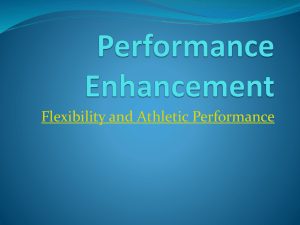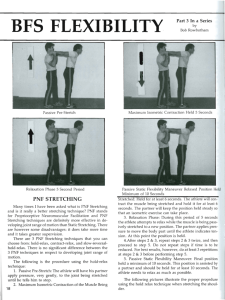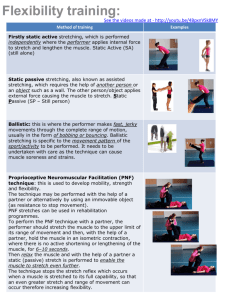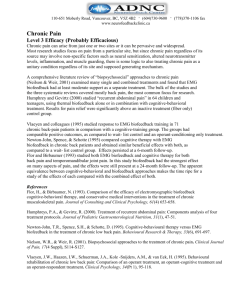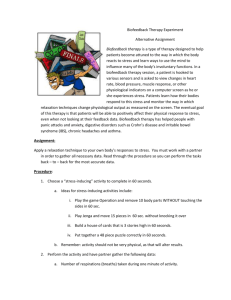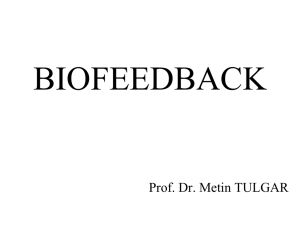-
advertisement
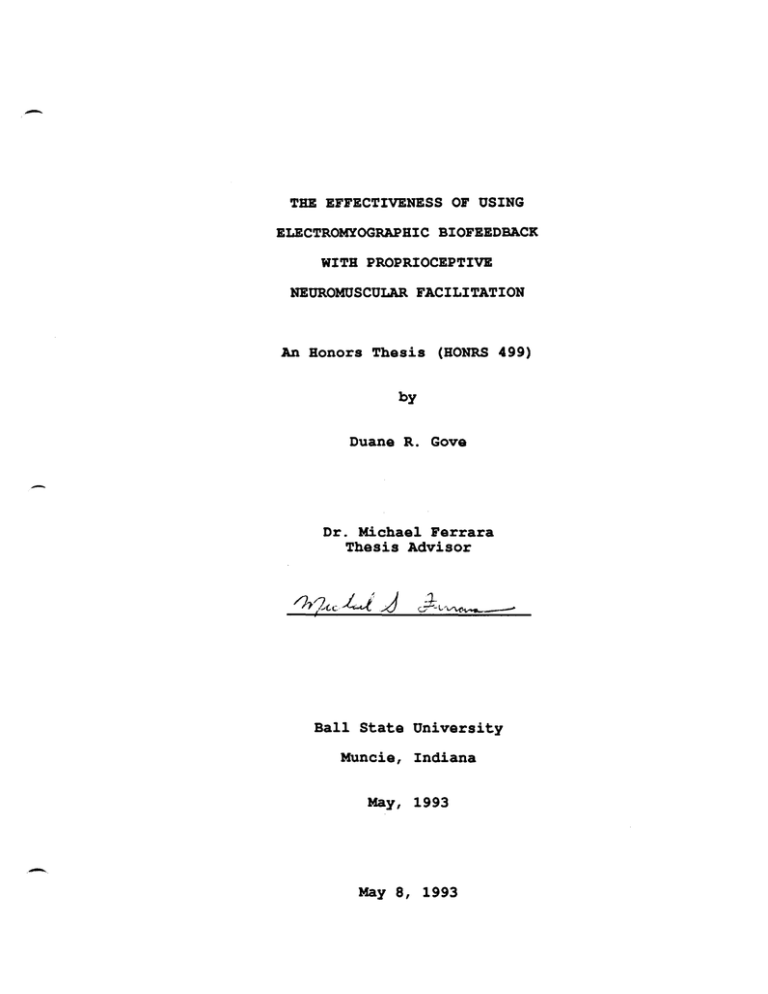
THE EFFECTIVENESS OF USING ELECTRO~OGRAPHIC BIOFEEDBACK WITH PROPRIOCEPTIVE NEUROMUSCULAR FACILITATION An Honors Thesis (HOHRS 499) by Duane R. Gove Dr. ~chael Ferrara Thesis Advisor Ball State University Muncie, Indiana May, 1993 - May 8, 1993 ,:::~CO!i ""1he:::.l5 1-1> :JW1 - \ tlD,·; , ,"" ·Gb~ ABSTRACT Proprioceptive neuromuscular facilitation (PNF) and electromyographic (EMG) biofeedback have typically been used as separate modalities in the practices of injury prevention and physical rehabilitation. The purpose of this project was to determine the effectiveness of using these two strategies simultaneously to increase hip range of motion. Two specific questions were raised--one comparing short term, or day by day, improvements in flexibility, and one comparing long-term results developed over the course of the project. It was hypothesized that using EMG biofeedback would create greater increases in range of motion for both - short and long term periods. Fourteen subjects completed a PNF protocol on each leg, three times a week for a period of three weeks. One leg of the subject was monitored with EMG biofeedback during the PNF exercises; the other leg served as the control leg with no EMG biofeedback. Statistical analysis of short term improvements in range of motion revealed that the inclusion of EMG biofeedback produced a 35% greater increase in hip range of motion, thus supporting the hypothesis. Analysis of the long-term effects showed that no significant difference existed between the groups, consequently rejecting the hypothesis. It is believed that increasing the number of PNF sessions per week may help maintain the short-term benefits of using EMG biofeedback. - i ACKNOWLEDGMENTS This project could not have been started nor completed without the advice and guidance of my advisor Dr. Mike Ferrara. His help is greatly appreciated, and his patience is admired. I would also like to thank Miss Kimberly Myers for lending her support and time during the execution phase of this project, and Dr. Thomas Weidner for his pinch-hitting advice. - ii TABLE OF CONTENTS Abstract i Acknowledgements . . . i i Introduction 1 Methods and Procedures 3 Subjects . . 3 PNF Protocol . 4 Instrumentation 5 Range of Motion 7 Statistical Analysis . 7 Results . . . . . 9 Discussion · 11 Conclusion · 16 References - . . . . . . . . . . . . . . . iii · 17 1 INTRODUCTION Increasing joint range of motion is a common practice for prevention of injury and physical rehabilitation. Many techniques exist that will aid in accomplishing greater range of motion. The most popular of these is stretching the surrounding muscles to improve flexibility. One particular method of stretching, referred to as proprioceptive neuromuscular facilitation (PNF), has been well documented as an effective means of augmenting muscle flexibility (4,5,10,11,12,13). As a result, PNF stretching has become a common method used by doctors, physical therapists, and athletic trainers to enhance range of motion. Another modality growing in popularity is electromyographic (EMG) biofeedback. Researchers have reported its effectiveness during muscle reeducation procedures for injury prevention and physical rehabilitation (2,3,6,7,8,14,16,17). With visual and/or auditory signals, an EMG biofeedback unit can aid the user in controlling a muscle's electrical activity more than if no biofeedback unit were used. Increasing the electrical activity creates greater muscle tension and can potentially result in larger strength gains. A decrease in motor unit activity can reduce muscle tension and allow a relaxation effect, which - . may contribute to increased flexibility . - 2 In modern injury prevention and physical rehabilitation practices, it is typical to utilize PNF and EMG biofeedback as two distinct procedures. Previous studies have investigated EMG activity during PNF stretching techniques, but the participating subjects did not receive any EMG biofeedback during their exercises (10,12). Research that did use EMG biofeedback principles with PNF stretching was not found. Based on the theories of EMG biofeedback and PNF stretching, a project on hip range of motion was developed. The purpose of the project was to investigate the effectiveness of using the two strategies simultaneously (PNF with EMG biofeedback) to increase hip range of motion. Two specific questions were raised--one comparing short term, or day by day, improvements in flexibility, and one comparing long-term results developed over the course of the three week experimental period. It was hypothesized that, for both short-term and long-term comparisons, the inclusion of EMG biofeedback with PNF would create a significantly greater increase in hip range of motion than PNF would when used alone. 3 METHODS AND PROCEDURES Subjects Fourteen volunteers from an introductory athletic training course were used as subjects. of nine males and five females. The group consisted Subjects participated in an initial screening and all were determined free of any injury or illness that could interfere with the results of the study. Also, hip flexion was measured during the screening process to compare bilateral range of motion in each subject, and no significant differences within the individual subjects were found. All project procedures were carried out in accordance with the protection of human subjects criteria. Each subject was randomly assigned an experimental leg (left or right) that utilized a PNF stretching protocol with EMG biofeedback. The other leg served as the control leg and completed the same PNF protocol without EMG biofeedback. For statistical reasons, a counter-balance design was established for the project: half of the subjects completed a stretching protocol on the experimental (biofeedback) leg first, and the other half completed the same protocol on the control (no biofeedback) leg first. Each leg performed the identical PNF stretching protocol three times per week, every other day, for a period of three weeks. To promote injury prevention, each subject completed a two minute stationary bike warm-up prior to performing the protocol. 4 PNF Protocol The PNF stretching method used for this study was consistent with the contract-relax technique described by Osternig, Robertson, Troxel, and Hansen (12), and by Moore and Hutton (10). The same procedure is referred to as the hold-relax technique by Cornelius and Craft-Hamm. (4). It involves a passive stretch of the hamstrings to the point of tension or discomfort, followed by a maximal isometric contraction of the stretched muscles. The method is then concluded with a relaxation period in which another passive stretch of the hamstring muscles is performed at a newly determined point of tension or discomfort. The duration of each isometric contraction and each stretch period, as well as the number of trials utilized, varied among previous researchers (4,5,10,12,13). For this project, the protocol was adapted from other PNF studies. Each isometric contraction phase lasted six seconds, which was concluded to be appropriate for achieving maximal results by Cornelius and Rauchuber (5) and by Nelson and Cornelius (11). The use of a ten second relaxation/stretch phase was based on research from Cornelius and Rauchuber (5) and Prentice (13). Moore and Hutton (10) and Cornelius and Craft-Hamm (4) served in determining the use of two sets of three contract-relax trials. Each leg of each subject, therefore, performed the following PNF protocol three times per week for the project's duration of three weeks. 5 1. Ten second passive static stretch at the point of hamstring tension or discomfort. 2. Six second isometric hamstring contraction (maximal) . 3. Ten second passive static stretch at the newly determined point of tension or discomfort. 4. Six second isometric contraction. 5. Ten second passive static stretch at new point. 6. Six second isometric contraction. 7. Ten second passive static stretch at new point. 8. (End of first set) One minute rest period. 9. Repeat steps 1 through 7 (second set) . Instrumentation EMG activity on the experimental legs was monitored by the Myolab II (Model ML-200) from Motion Control (Salt Lake City, Utah). The unit provided both auditory and visual biofeedback to the subject to maximize his/her efforts during the contraction phases of the PNF protocol. Two preamplifiers containing three electrode discs each were placed on the skin's surface over the hamstring musculature. In accordance with Basmajian and Blumenstein (2), one preamplifier was placed over the mid-portion of the biceps femoris and the other was placed over the mid-portions of the semimembranosus and semitendinosus. Medical tape was used to affix the preamplifiers to the skin, and additional security was provided by an elastic strap wrapped around the subject's thigh. - 6 Skin preparation for preamplifier placement included cleaning the area with alcohol and a sterile gauze pad. The area was then dried with a clean cotton towel for maximal tape adhesion. After the preamplifier attachment, water, acting as the conductive medium, was placed between the electrodes and skin surface with a Q-tip applicator. (2) Visual biofeedback of the subject's isometric hamstring contractions was provided by two meters with needle indicators. a Each meter displays microvolt EMG activity on a to 100 scale, and gain dials are used to manipulate amplification. For this project, as recommended. by the Myolab II Instruction Guide, the gain dials were adjusted before and during the PNF protocol so the needles read between 50 and 70 microvolts on each meter during the contraction phases. Subjects were advised to closely watch the meters during their isometric contractions and attempt to attain a reading of 100 microvolts on each meter by maximizing the contractions. The auditory biofeedback provided by the Myolab II is a steady tone that is initiated when EMG activity is detected within the monitored muscle(s). As an increase in EMG activity--a stronger muscle contraction--occurs, the tone becomes higher in pitch. Subjects were instructed to create the highest pitch possible by increasing the intensity of - their isometric contractions. 7 Range of Motion Range of motion measurements were completed with the subject lying supine on a standard treatment table. The inactive leg was secured at all times to the table by a large velcro strap. For all measurements, the knee was kept at full extension, and the leg was passively moved into hip flexion until muscle tension or subject discomfort was noted. The axis of the goniometer was placed on the greater trochanter of the femur with the stable arm along the lateral mid-line of the subject's trunk and the moveable arm parallel to the lateral aspect of the femur. All range of motion measurements (pre- and post-exercise) were taken three times. For consistency all measurements were taken by the same experimenter. Statistical Analysis The means of the three pre-exercise and the three postexercise range of motion measurements were calculated and used as a basis for the statistical analysis. was focused on answering two questions: The analysis 1) Compared to the use of PNF stretching alone, what were the daily variations in flexibility created by the inclusion of EMG biofeedback? and 2) What were the long term effects of using EMG biofeedback with PNF stretching on hip flexibility? The analysis of the short term effects compared the differences between daily pre-exercise and post-exercise measurements of the experimental and control legs. The long term analysis 8 compared the differences achieved over the three week course of the project. A multiple analysis of variance (MANOVA) was completed and the alpha level to determine statistical significance was set at p < .05. To be included in the analysis, subjects must have completed all nine exercise sessions; one subject was omitted from the analysis due to missing data. 9 RESULTS Demographic information of the subjects is displayed in Table I on page 10. The results of the short-term statistical analysis (see Figure 1) showed that there was a significant difference (p<.OOl) between the experimental and control legs. The legs that performed the PNF protocol with EMG biofeedback had a far greater increase in range of motion than the control legs. On average, the daily variation revealed that improvements created by biofeedback were approximately 35% greater than the improvements of the control legs. - Daily Improvements in ROM 11.5 11 10.5 10 Degrees 9.5 9 of 8.5 8 Improvement 7.5 7 8.5 - - Biofeedback Leg ----- Control Leg 8 5.5 - 5 4.5 -'---,----,----,----,----,-----.---.---.---. 1 2 3 4 5 8 7 8 9 Day Figure 1 10 Tabla I Demographic Information on 14 Subjects Males Females Mean Age Mean Wt. Mean Ht. 9 5 19.5 167.43 lbs. 69 inches The long-term statistical analysis demonstrated no significant difference (p>.05) between the two groups. The average increase in range of the motion for the control legs was actually 8% greater than the experimental group. These results are seen below in Figure 2. - Long Term Improvements in ROM ....... -_ __ ... .--- ..... ,,,.. /-_ .. -- .. / , .. .// / / :/ / . - EMG Monitored Leg ---.. - Control Leg .,,/."' _,.I'" ,/ . I I 3 4 5 8 Day 7 8 9 11 DISCUSSION PNF stretching methods and EMG biofeedback have traditionally been utilized as separate modalities in the practice of injury prevention and physical rehabilitation. Each has been studied extensively and shown to be very effective when used under the correct circumstances. This study incorporated the principles of these two entities into a single treatment protocol with the belief that, when compared to the use of PNF alone, greater increases in hip range of motion could result. Most stretching methods, including the contract-relax PNF stretching technique used in this project, are based on a neuromuscular mechanism known as the stretch reflex. There are two types of receptors in muscle and tendon tissues that allow the stretch reflex to occur: spindles and Golgi tendon organs (13). muscles Muscles spindles monitor alterations in a muscle's length by reacting to the degree and rate of change (15). Stretching a muscle will initiate the stretch reflex and cause the spindle to increase its impulse transmission to the central nervous system. The response is an increase in motor nerve impulse transmission to the same muscle, elevating muscle tension to resist the initial stretch. Golgi tendon organs react in opposition to the muscle spindles by responding to changes in muscle tension. An increase in muscle tension caused by the muscle spindle will stimulate the Golgi tendon organs to 12 send their own impulses to the central nervous system. Motor nerve impulse transmission to the muscle is decreased and a relaxation effect ensues (13,15). The stretch reflex is amplified by a neurophysiologic event called autogenic inhibition (10,13). When a muscle is stretched the central nervous system receives impulses from both muscle spindles and Golgi tendon organs. If the stretch is held for an extended period of time, autogenic inhibition will occur: the effects of the Golgi tendon organs will gradually overpower the effects of t.he muscle spindle (13). As a result, the muscle will become more relaxed and a greater stretch may be accomplished. The contract-relax method of PNF used in this project carries autogenic inhibition one step further. A maximal isometric contraction of a muscle in a stretched position will create much greater tension in the muscle then a stretch will alone. This greater muscle tension will increase the stimulation of the Golgi tendon organs. The inhibitory effects on the muscle are, therefore, augmented as a result of the isometric contraction (13). This phenomenon gives PNF stretching techniques a considerable advantage over the traditional static stretching methods. Electromyography, like PNF, has received a considerable amount of attention as an effective modality. The traditional applications of it in biofeedback therapy include the management and treatment of headaches, Reynaud's 13 disease, insomnia, and hypertension (6,14). Muscle reeducation is the primary purpose of EMG biofeedback, serving as an effective means for increasing muscle activity as well as reducing spasticity (3,6,7). The basis of electromyography is the detection of electrical muscle action potentials that are generated when a muscle fiber contracts. Stronger contractions, or greater muscle tension, is the result of an increase in the muscle's electrical activity. Electrodes may be placed within the muscle itself and used to monitor the changes in electrical activity of a single muscle fiber. Surface electrodes, like those employed in this project, detect the action of numerous motor units whose electrical signals are diffused through the skin. (3) Measured in microvolts, the EMG patterns of specific muscles can be recorded during exercise sessions and analyzed to determine the effectiveness of the exercises performed (6,10,12). The same patterns can also be amplified and presented to the exerciser during designated activities. In the form of audio and/or visual cues, this biofeedback of EMG activity can teach the receiver to alter the levels of muscle tension (8). Research has demonstrated that the use of auditory and visual feedback is directly proportional to the magnitude of a muscle contraction that is monitored by EMG electrodes (16). Perceiving a muscle's electrical activity and attempting to increase it will, ,- 14 therefore, allow a person to produce a greater muscle contraction. In this project the purpose of utilizing EMG biofeedback with a PNF stretching technique was to assist the subjects in maximizing their isometric contractions and creating greater increases in range of motion. It was believed that the greater amounts of muscle tension produced with the biofeedback application would allow maximal excitation of the Golgi tendon organs and, therefore, augment the effects of autogenic inhibition. Based on this concept, it was hypothesized that for both short-term and - long-term range of motion comparisons, the inclusion of EMG biofeedback with PNF would create a significantly greater increase in hip range of motion than PNF would when used alone. The statistical analysis of the short-term increases in range of motion revealed that a significant difference between the two methods existed. The average increase in range of motion of the experimental legs was 35% greater than the average increase of the control legs and lends support to the hypothesis. It appears that the addition of EMG biofeedback to a PNF stretching protocol can yield greater increases in range of motion. These results may prove to be beneficial for the fields of physical therapy ,- and athletic training, where faster and more effective means 15 of improving flexibility are constantly being sought to foster injury prevention and physical rehabilitation. The results of the long-term statistical analysis demonstrated that no significant differences existed between experimental and control legs. Average increases in flexibility gained over the three weeks of this project were relatively equal for both groups of legs. This rejects the hypothesis and may be an indication that using EMG biofeedback with PNF stretching is not a more effective means of maintaining flexibility than using PNF stretching alone. However, it may also indicate that the project's design of performing the PNF protocol only three days per week is not adequate in maintaining the short-term benefits that EMG biofeedback provided. Different long-term results may occur if EMG biofeedback is utilized with PNF stretching five or six consecutive days per week instead of three. - - 16 CONCLUSION This investigation indicates that the inclusion of EMG biofeedback with PNF stretching is an effective means of increasing hip range of motion. Also demonstrated was that, when compared on a day by day basis to the use of PNF stretching alone, greater increases in hip range of motion are possible if the subjects are furnished with EMG biofeedback during their isometric contraction phases. These differences may provide a rationale for the clinical use of EMG biofeedback with PNF stretching. Not supported by this study was that the lasting effects of using EMG biofeedback with PNF stretching were better than those of PNF stretching alone. It is not certain why the short-term benefits of EMG biofeedback did not persist through the three week duration of this project, but it may be attributed to an inadequate number of exercise sessions per week. An increase in the number of sessions per week may aid the subjects in maintaining the short-term benefits of using EMG biofeedback. Future investigations employing the principles of EMG biofeedback and PNF stretching may prove to be advantageous for the practices of injury prevention and physical rehabilitation. - - 17 REFERENCES - 1. Basmajian JV. Biofeedback: the clinical tool behind the catchword. Modern Medicine. 1976; 44: 60-64. 2. Basmajian JV, Blumenstein R. Electrode Placement in EMG Biofeedback. Baltimore, MD: Williams & Wilkins; 1980: 7-9, 81. 3. Blanchard EB, Epstein LH. A Biofeedback Primer. Reading, MS: Addison-Wesley Publishing; 1978: 89109. 4. Cornelius WL, Craft-Hamm K. Proprioceptive neuromuscular facilitation flexibility techniques: acute effects on arterial blood pressure. The Physician and Sports Medicine. 1988; 16: 152-161. 5. Cornelius WL, Rauschuber MR. The relationship between isometric contraction durations and improvement in acute hip joint flexibility. Journal of Applied Sport Science Research. 1987; 1: 39-41. 6. Danskin DG, Crow MA. Biofeedback: An Introduction and Guide. Palo Alto, CA: Mayfield Publishing; 1981: 2-4, 38-48. 7. DeBacher G. Biofeedback in spasticity control. In: Basmajian JV, ed. Biofeedback: Principles and Practice for Clinicians. Baltimore, MD: Williams & Wilkins; 1983: 111-129. 8. Gans DS. Biofeedback and sports medicine. In: Sandweiss JH, Wolf SL, eds. Biofeedback and Sports Science. New York, NY: Plenum Press; 1985: 147-158. 9. Lucca JA, Recchiuti SJ. Effect of electromyographic biofeedback on an isometric strengthening program. Physical Therapy. 1983; 63: 200-203. 10. Moore MA, Huttom RS. Electromyographic investigation of muscle stretching techniques. Medicine and Science in Sports and Exercise. 1980; 12: 322-329. 11. Nelson KC, Cornelius WL. The relationship between isometric contraction durations and improvement in shoulder joint range of motion. Journal of Sports Medicine and Physical Fitness. 1991; 31: 385-388. - - r- 18 12. Osernig LR, Robertson RN, Troxel RK, Hansen P. Differential responses to proprioceptive neuromuscular facilitation stretch techniques. Medicine and Science in Sports and Exercise. 1989; 22: 106-110. 13. Prentice WE. A comparison of static stretching and PNF stretching for improving hip joint flexibility. Athletic Training. 1983; 21: 56-59. 14. Sandweiss JH. Biofeedback and sports science. In: Sandweiss JH, Wolf SL, eds. Biofeedback and Sports Science. New York, NY: Plenum Press; 1985: 1-31. 15. Tortora GJ, Anagnostakos NP. Principles of Anatomy and Physiology. 6th ed. New York, NY: Harper & Row; 1990: 364-365. 16. Wolf SL. Biofeedback applications in rehabilitation medicine: implications for performance in sports. In: Sandweiss JH, Wolf SL, eds. Biofeedback and Sports Science. New York, NY: Plenum Press; 1985: 159-180. 17. Wolf SL, Binder-MaCleod SA. Electromyographic biofeedback in the physical therapy clinic. In: Basmajian JV, ed. Biofeedback: Principles and Practice for Clinicians. Baltimore, MD: Williams & Wilkins; 1983: 62-72.

